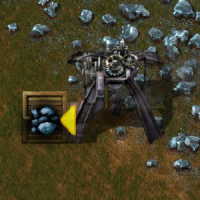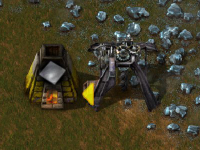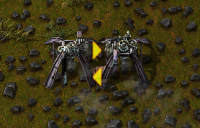Mining: Difference between revisions
→Output: modified the formatting of "big mining drill" from earlier edit that was accidentally submitted. Earlier edit was to correct the "Output" table, which incorrectly calculated the big mining drill's resource drain reduction as though it was productivity, and added some text to explain the difference between the two. |
|||
| Line 109: | Line 109: | ||
|} | |} | ||
Note: While the | Note: While the big mining drill is listed as having only 50% resource drain, this is not the same thing as productivity, and does not increase the effective output speed of the miner. Productivity creates extra ore products for every "real" ore mined from the patch, whereas resource drain reduction (at the 50% level that normal quality big mining drills have) means that only every other "real" ore that is mined actually depletes the patch. That is to say, where the big mining drill mines scrap at 5/s, it reduces the richness of the scrap patch beneath it by 2.5/s. | ||
The above figures are modified by [[Mining productivity (research)|mining productivity]] technology, which adds to any bonus from productivity modules. Productivity itself multiplies directly with the resource drain reduction effect of the | The above figures are modified by [[Mining productivity (research)|mining productivity]] technology, which adds to any bonus from productivity modules. Productivity itself multiplies directly with the resource drain reduction effect of the big mining drill. For example, a patch worth 1M ore is worth 2M ore at 100% productivity, and if normal big mining drills are used, that patch is instead worth 4M ore. Legendary big mining drills instead have a resource drain of 8%, so that 1M patch would instead be worth 25M ore. | ||
Unlike most other equipment, mining drills will output resources directly without the need of [[inserter]]s. This includes [[transport belts]], [[chests]], other mining drills, [[furnace]]s, [[assembling machine]]s, etc. | Unlike most other equipment, mining drills will output resources directly without the need of [[inserter]]s. This includes [[transport belts]], [[chests]], other mining drills, [[furnace]]s, [[assembling machine]]s, etc. | ||
Revision as of 23:15, 22 November 2024
Mining is used to extract resources from the world. Mining drills are the first step to automating manufacture, although most resources have to be smelted in a furnace for further usage.
Mining speed formula
The rate at which resources are produced is given by:
Mining speed / Mining time = Production rate (in resource/sec)
To calculate the time needed for one resource-item use this formula:
Mining time / Mining speed = Seconds for one resource item
Mining speed is a function of the miner while mining time is a function of the metal or mineral you are currently mining (you can place a miner over a mixed field).
Mining by hand
When mining by hand, the formula is modified slightly:
(1 + Mining Speed Modifier) * .5 / Mining time = Production rate (in resource/sec)

Expanded description:
(1 + Force Modifier) * (1 + Character Modifier) * (Character mining speed) / Mining time = Rate
Infinite resources
The output of the unmodified resource is the percentage yield of the tile currently used by the miner.
Output of unmodified field * ( Number of modules in miner * Bonus from module ) + Output of unmodified field * ( Number of beacons * ( Number of modules * Distribution efficiency ) * Bonus from module + Productivity research bonus + 1 ) = Raw output per second
(Raw output per second * Mining speed) / Mining time = Production rate (in resource/sec)
The mining drill or pumpjack will sum the production rate of all tiles below it and show that value in the tooltip.
Drill types
| Item | Total raw | Mining speed | Mining power | Covered area | Max health | Pollution |
|---|---|---|---|---|---|---|
| Player | - | 0.5 | - | 1 × 1 | 250 | - |
| Burner mining drill | 0.25 | 150 kW (burner) | 2 × 2 | 150 | 12/m | |
| Electric mining drill | 0.5 | 90 kW (electric) | 5 × 5 | 300 | 10/m | |
| Big mining drill |
2.5 | 300kW (electric) | 13x13 | 300 | 40/m |
Note, that the Burner mining drill covers exactly its size (2×2, the covered area is also 2×2), while the Electric mining drill is one tile bigger (size is 3×3, but covered area is 5×5), and the Big mining drill is two tiles bigger than the electric mining drill (size is 5x5, and area covered is 13x13).
Mining drills can only be placed on resources.
Output
| Resource | Burner M. Drill | Electric M. Drill | Big M. Drill | |
|---|---|---|---|---|
| Speed: 0.25 | Speed: 0.5 | Speed: 2.5 | ||
| Scrap | Time: 0.5 | |||
| Iron | Time: 1 | |||
| Copper | Time: 1 | |||
| Coal | Time: 1 | |||
| Stone | Time: 1 | |||
| Calcite | Time: 1 | |||
| Uranium | Time: 2 | |||
| Tungsten | Time: 5 | |||
Note: While the big mining drill is listed as having only 50% resource drain, this is not the same thing as productivity, and does not increase the effective output speed of the miner. Productivity creates extra ore products for every "real" ore mined from the patch, whereas resource drain reduction (at the 50% level that normal quality big mining drills have) means that only every other "real" ore that is mined actually depletes the patch. That is to say, where the big mining drill mines scrap at 5/s, it reduces the richness of the scrap patch beneath it by 2.5/s.
The above figures are modified by mining productivity technology, which adds to any bonus from productivity modules. Productivity itself multiplies directly with the resource drain reduction effect of the big mining drill. For example, a patch worth 1M ore is worth 2M ore at 100% productivity, and if normal big mining drills are used, that patch is instead worth 4M ore. Legendary big mining drills instead have a resource drain of 8%, so that 1M patch would instead be worth 25M ore.
Unlike most other equipment, mining drills will output resources directly without the need of inserters. This includes transport belts, chests, other mining drills, furnaces, assembling machines, etc.


